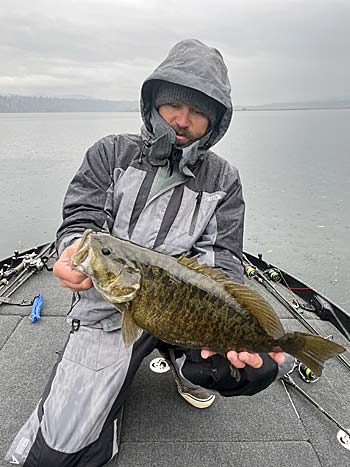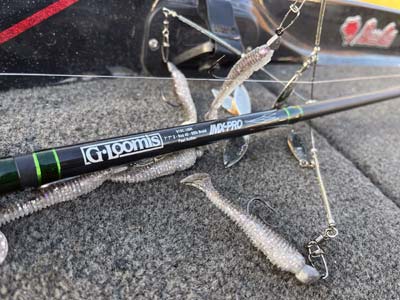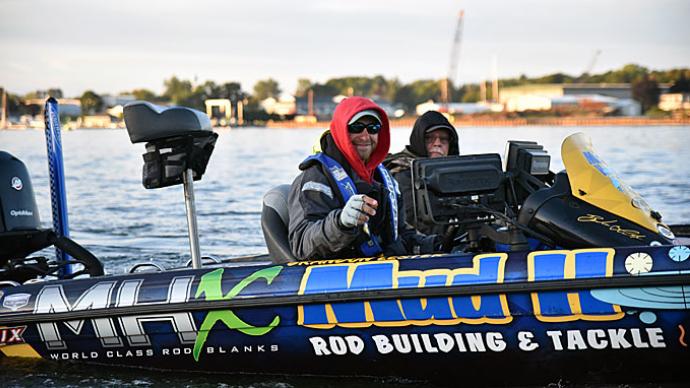
The winter months generally mean slowing down and fishing at a snail's pace, but there is still great fishing to be had when the water is cold and the bass move deep. Clear water fisheries can be excellent during winter with the right approach, outlook, and willingness to ply deeper waters. Bass in clear water generally tend to go deeper on clear water fisheries, especially during the winter months, and knowing where to look and what lures to try will help you master the art of catching bass in deep and clear water.
Deep Is Relative And What To Look For
What one angler considers deep water may be drastically different than another angler in another part of the country. On some bodies of water, 15 to 20 feet might be a deep hole or even the deepest part of the lake, and on others, anglers may find success much deeper, often catching bass in 40, 50 feet, or even deeper.
There is a limit to how deep bass will go during the winter months, and each lake is different, but it primarily comes down to baitfish and the underwater habitat. Both of those can be found with map study and the help of your electronics.
When the water is cold, and you find yourself bass fishing a clear water fishery, one of the first things you should seek is baitfish. Chances are that if you find a school of baitfish, the bass and other predators will be close by. Finding schools of shad and other baitfish becomes much easier with the help of your electronics, but other telltale signs include watching for bird activity and fish schooling on the surface.
Another essential factor for finding deep water fish is locating structure and cover. This can also be done with the help of your electronics and some time behind the wheel idling and looking for fish-holding objects such as rocks, humps, submerged trees, timber, brush piles, and more. Mark any of these likely areas with a waypoint and continue to search for more. Having many of these areas will allow you to run from spot to spot and fish high-percentage areas.

Map study is another often overlooked part of winter fishing. Using your lake maps to locate points, submerged islands, creek channels, and drains will give you a starting point when you begin your search on the water while looking at your electronics.
Utilizing Your Forward-Facing Sonar
This technology has created a firestorm in the past few years, with many anglers opposed to it and others embracing it to catch more fish. No matter where you stand on the issue, the technology can significantly speed up the learning curve and increase your success in deep water. It's not a magic tool that will instantly allow you to catch every fish in the lake, but it helps show where the baitfish are and watch fish activity. It's also beneficial for finding offshore rocks, underwater points, high spots, and drop-offs that can all produce fish in deep and cold water.
Forward-facing sonar is also helpful when watching your lures in the water. It allows you to see if a fish is following the bait, and then you can alter your retrieve and cadence until you figure out how to trigger a bite. This is important all year long but can be critical when fishing in cold water when the fish are more lethargic. It also allows you to experiment with different lures until you find one that will work that day and for that specific bass.
Three Baits To Try
Many different baits will work when the water is cold, and you are fishing a clear body of water, but generally, things that imitate shad will be solid options. Three of the best are jerkbaits, Alabama Rigs, and fluke-style baits on a jighead. Each can be fished in the middle of the water column and does a great job attracting fish since clear-water bass use sight to feed more than those in dirtier water.

An Alabama Rig does not look very natural with wires and hooks everywhere, but the appearance of a small school of shad swimming around is enough to get a bass to look past that and zone in on the baits. These contraptions excel in clear water because bass can see them a long way away, and the swimbaits get them to bite when the water is cold since they are keyed in on baitfish. Each state has different rules regarding how many hooks and baits are allowed on the rigs, but no matter how many you can use, you'll have a rig that imitates a school of baitfish better than any other lure.
Jerkbaits are another category of lures that excel in cold water and do very well in clear water for the same reasons other lures work; bass can see them from far away and make their way to the bait. When choosing colors for clear water, translucent patterns do well in most instances, but solid colors do better in lowlight conditions due to the time of day or cloud cover.
Another excellent choice is a fluke-style bait fished through the water column. This is often called a 'Damiki Rig' or mid-strolling, allowing you to fish the bait virtually any depth. This is one technique that significantly helps with your electronics because you can see precisely where the bass are in the water column and keep your bait above the fish at all times. This approach is deadly for deep waters and for clear water fishing.
Fishing deep and clear water can seem overwhelming, but it's better than fishing dirty water in the colder months; the fish will bite when you put a bait in front of them. The key with all fishing situations is knowing where to look and being around fish, making using your electronics paramount during winter.




